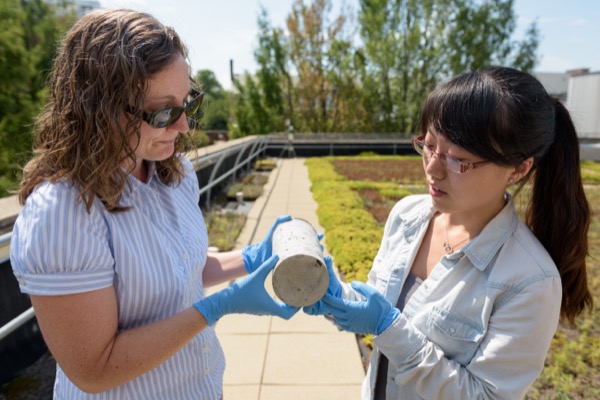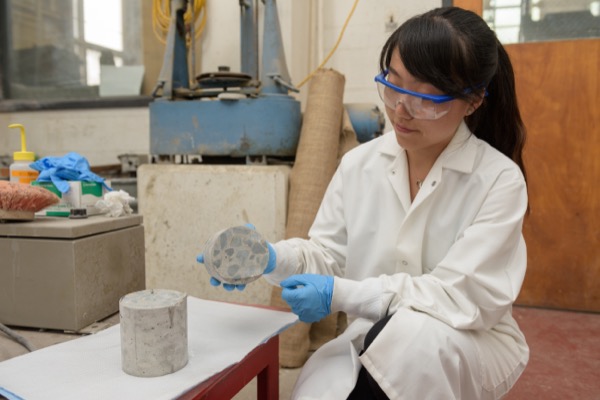


Concrete evidence
Bacteria may be harbingers of invisible damage in concrete
8:34 a.m., Aug. 31, 2015--A small “garden” of concrete cylinders shares space with the colorful sedum, chives and crocus on Colburn Lab’s green roof at the University of Delaware.
Although the cylinders themselves aren’t alive, bacteria living on or in them could serve as valuable indicators of damage growing inside the concrete.
Research Stories
Chronic wounds
Prof. Heck's legacy
Located on the green roof because it offers access to daily weather data, the cylinders are part of a research study led by microbiologist Julia Maresca, an assistant professor in UD’s Department of Civil and Environmental Engineering.
Maresca hopes to find biomarkers that can tell inspectors whether concrete has been damaged before that damage is visible to the naked eye.
The current effort focuses on damage from a problem common in the Mid-Atlantic region called the alkali-silica reaction, or ASR. When silica, other cations, and water react in concrete, a gel is formed that expands inside the concrete, causing extensive cracking.
“Bacteria require specific environmental conditions,” says Maresca. “If chemical damage occurs, those conditions change. We predict that in response to chemical changes caused by the alkali-silica reaction, the kinds of bacteria living there may also then change. If certain kinds of bacteria appear only when ASR has occurred, their presence could be used as a bio-indicator for damage.”
To identify candidate bacteria, Maresca worked with structural engineer Thomas Schumacher to prepare a set of concrete test cylinders using materials that are highly susceptible to ASR and a parallel set made of materials resistant to this reaction. All of the cylinders were placed on the green roof in the spring of 2013. Since then, one pair of cylinders has been removed every four to six weeks for analysis of the bacterial populations.
Maresca explains that because very few bacteria can be cultivated in the laboratory, DNA analysis is needed to identify the bacteria living on and in the concrete. Doctoral student Keira Zhang discovered that a method used to extract DNA from ancient bones also worked on concrete. Using this method, DNA from all of the cylinders removed from the green roof over the past two years is underway.
“Analysis of this DNA will show how microbial communities in and on concrete vary over time as ASR-susceptible and ASR-resistant concrete weathers,” Maresca says. “After we identify potential bio-indicators, our next step will be to analyze undamaged and ASR-damaged field samples to see whether the predictions we made using laboratory samples hold true in the field.”
“If our initial prediction is correct, this research will lead to development of a simple test for specific bacterial bio-indicators for ASR-susceptible roadways,” she adds. “Early detection of ASR damage will enable state and local departments of transportation to remediate roadways before extensive cracking has occurred.”
About the research
The Delaware Department of Transportation provided concrete materials and mix designs for the test cylinders, and Devin Harris at the University of Virginia will provide field samples.
Seed funding for the project was provided by the University of Delaware Research Foundation, and the research is currently funded by the Mid-Atlantic Transportation Sustainability University Transportation Center.
Undergraduate research assistants Mary-Katherine Sutter, Paul Moser and Alison Treglia also contributed to the work.
Article by Diane Kukich
Photos by Evan Krape









